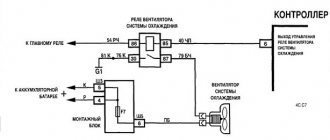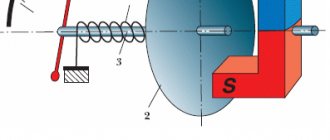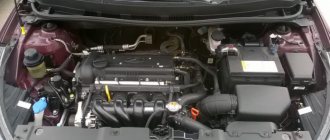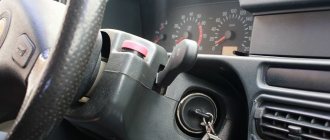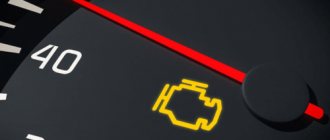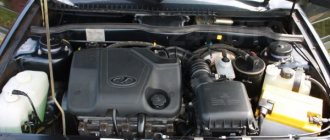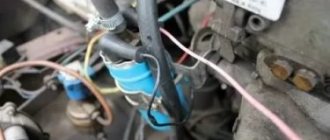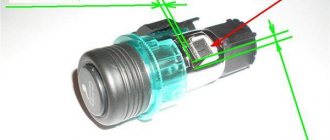As practice shows, failure of the speedometer and tachometer is a fairly common occurrence.
On the one hand, such breakdowns do not affect the basic functions of the car, but on the other hand, the driver does not receive important information, which can lead to more serious malfunctions or even an accident.
Therefore, if your speedometer stops working or the tachometer needle begins to “take on a life of its own,” you need to urgently take some action.
In this article we will look at what and how to do.
Why the tachometer does not work on the VAZ 2114
Quite often, in domestic cars equipped with ECUs, there are malfunctions in the operation of the dashboard instruments. These include the tachometer.
Many drivers, especially beginners, ask the question why the tachometer on the VAZ 2114 does not work ? There may be several reasons for this.
First, let's check the serviceability of the indicator itself; to do this, we carry out diagnostics on the instrument panel by clicking on the odometer reset, with the ignition off, turn on the ignition, as a result of which all the instrument panel arrows should rise to the maximum level and return back. If the tachometer needle does not respond during diagnostics, the pointer is most likely faulty; the remedy is to replace the instrument panel. It’s even easier to check the indicator, if the car has an on-board computer and it shows the revolutions, it means the problem is in the indicator.
Sometimes a malfunction occurs, expressed in jumps in the tachometer needle, or periodic shutdowns (works, does not work), most likely the fault here is poor contact in the wire blocks that supply and control the tachometer, or weak ground contact, on the tachometer or on ECU. It is also possible that the control circuit from the computer to the tachometer may be broken. The solution is to check the quality of the contacts on all tachometer wires. Also, the tachometer may not work together with all the other devices; the reason here is most likely in the supply of power to the panel, or rather its absence or not constant contact. The elimination method is to eliminate the cause of the lack of power - a blown fuse or an open circuit.
So, why does the tachometer on the VAZ 2114 not work? It does not work because either the device itself is faulty, or the circuits that supply and control it have a break or unauthorized contact, i.e. short circuit.
Source
The most common breakdown
Before digging into the inside of the car, check how securely the ground wire leading to the front panel is secured. A restless passenger in front often simply pulls him out of his place with his feet. To prevent the situation from repeating itself, after fastening it is worth insulating the wire from reach. The situation is a little more complicated
Its signs are very characteristic:
- All indicators do not work:
speedometer, tachometer, odometer, fuel level recorder, coolant temperature sensor; - The rest of the equipment - optics, radio, even the panel backlight - turn on normally and do not act up;
- The ignition works properly, the car does not refuse to start;
- Fuse F3 is
almost 100% . It is located in the mounting block and will have to be changed. But first you need to find out why it was covered, otherwise the new one installed will suffer the same fate. In most cases, a short circuit is to blame for burnout. On well-used VAZ-2114, the fuse often blows after each wash. Instead of carrying a spare one, you need to figure out where moisture is getting into it.
If the fuse is intact, this is not a reason to immediately leave it alone. It would be a good idea to remove it and check the contacts: if the fuse is live, but the terminals are oxidized, the circuit will be interrupted, and the device will stop showing any signs of life.
Why does the tachometer not work on a VAZ-2114 car with an injector?
VAZ cars never cease to be improved. Now the latest models come off the assembly line with injection power units. Such engines are built according to a complex scheme of interaction between many sensors and an on-board computer. The article will reveal a number of reasons why the tachometer on the VAZ-2114 does not work.
The purpose of the tachometer, symptoms and causes of malfunction of this device will also be described. At the end of the article, a schematic diagram of connecting the engine revolution counter will be given.
Analogs
Original speed sensors for injection VAZ-2114 are marked with article number 2111-3843010. This is a part in a plastic case, with a drive gear made of the same metal. The German analogue in a metal case is also suitable for this car model, but to install it you will have to redo the electrical contact socket.
Domestic EMFs are quite reliable. Their declared service life is up to 100–150 thousand kilometers. Rapid wear occurs due to dirt or damage to the housing itself during the repair of other components. You just need to monitor the condition of the part during operation.
Purpose
A car's tachometer is necessary to visually monitor engine speed. This control is very convenient for novice car enthusiasts and owners of cars with a manual transmission. On fuel-injected cars, the tachometer is also an additional means of monitoring speed for the on-board computer. Together with the crankshaft position sensors, speed and detonation sensors, the hog computer compares the received electrical impulses, thereby regulating the injection and oxygen saturation of the fuel.
Knock sensor, DTOZH, speed and others
In addition to the above mechanisms, other very important devices can be found in various corners of the engine compartment. The location of the VAZ-2114 injector sensors is quite chaotic, some are located directly on the power unit, others in other places - the gearbox, on electrical circuits.
Some equally important mechanisms include:
- The knock sensor is sensitive to various engine vibrations. Based on the received pulses, the ECU determines the qualitative composition of the mixture. Located on the cylinder block.
Engine temperature sensor - the only and simple, but extremely important task assigned to this device is to monitor the coolant temperature.
Speed sensor – from the name itself it is clear that this controller is necessary to measure the speed of a car. The DS transmits impulses to the ECU, which processes them and determines the speed of the car; the resulting result is displayed on the instrument panel by the speedometer.
Idling speed – not only reads information, but also corrects engine operation. DXH, using a special needle, controls the pipe - closes and opens. Due to this, the amount of oxygen supplied to the throttle assembly changes.
Mass air flow sensor - reads the data and transmits it to the control unit, which, based on the information received, determines the optimal ratio of the various components of the fuel-air mixture. A breakdown of the air flow sensor leads to the fact that the car significantly loses power, and the driver begins to feel a significant increase in the amount of gasoline consumed by the car.
DC - oxygen sensor, lambda probe. This controller is called differently among car enthusiasts, but the principle of its operation does not change. The DC informs the control unit about the amount of oxygen in the exhaust gases. The mechanism can be found in the receiving manifold.
These are the main and most significant sensors in the “fourteenth” system. It is also worth mentioning the FLS, which plays an important role - it determines the level of gasoline in the vehicle tank. Domestic drivers often experience difficulties with this device. Sometimes it works incorrectly and misinforms. But, as a rule, the FLS breaks down in old cars. You can repair the mechanism yourself, but it all depends on the severity of the breakdown.
Device
The tachometer of the VAZ “fourteenth” model is very simple. Its basis is the car's ignition module. This device contains a Hall pulse chopper. Due to the rotation of this device, an electrical impulse is generated. For one revolution of the crankshaft, only 2 discharges are formed (for 1–3 and 2–4 pistons). These signals are transmitted to the on-board computer. The ECU calculates the speed and number of received pulses. Based on these data, the magnitude of the electrical signal and its duration are calculated, which will be transmitted to the tachometer receiving unit in the car. Also, an exactly identical signal, but with a higher frequency, comes to the ECU from the crankshaft sensor. The computer compares the number of pulses and transmits the result in the form of a pulse voltage to the tachometer itself, located on the dashboard of the car. Two completely different devices allow you to obtain the most accurate data on the number of revolutions of the power unit.
Classification by operating principle
- Mechanical or electromechanical tachometers with direct drive. The revolutions are transmitted to the dial indicator through a flexible shaft, which, through a worm gear, receives rotation directly from the crankshaft or one of the transmission shafts. The operating principle of the indicator is based on the phenomenon of eddy current induction. The operation and design of a magnetic tachometer are extremely similar to the operating principle of a car speedometer. In modern cars, a similar tachometer design is not used.
- Electric machine. A distinctive feature is the connection to a generator. It is used primarily on diesel engines, but for the purpose of unification, a device of this type can also be used on gasoline engines.
- Electronic. The signal can be taken either from the ignition system or directly from the computer. Installed on gasoline and diesel internal combustion engines.
Design and principle of operation
Main components of electric machine and electronic tachometers:
- measuring unit, or signal converter. It can be based on elements of analog circuitry or built using special microcircuits;
- display unit with analogue or digital display of the number of revolutions;
- auxiliary elements.
The operation of electronic tachometers is based on the conversion of individual signals or pulses captured from the computer, ignition system or generator into a signal “understandable” for the display unit.
Connection diagram
When looking for the reason why the tachometer does not work, it is first of all important to understand the connection diagram and the type of signal. There are 3 typical connection schemes:
- to a contactless ignition system (the tachometer wire is connected to the primary circuit of the ignition coil). The operating principle is based on measuring the frequency of voltage surges in the primary circuit of the ignition system. Calculating the ignition angle is impossible without focusing on the number of crankshaft revolutions, therefore the sparking frequency directly depends on the crankshaft rotation speed. On 4-cylinder internal combustion engines, a full revolution of the crankshaft corresponds to 2 voltage pulses in the primary circuit. Accordingly, the higher the crankshaft rotation speed, the greater the frequency of voltage surges;
- connection to the contact ignition system. The operating principle and connection diagram are similar to the BSZ, but the design of the measuring unit will differ depending on the voltage of the input circuit;
- connection to the engine ECU. The principle of operation is still based on recording voltage pulses in the primary circuit of the ignition system, but the signal to the tachometer comes from the engine control unit;
- connection to the generator (the tachometer signal contact is connected to terminal W of the generator). The rotation of the generator pulley is carried out by a belt drive from the crankshaft, so the rotation speed of the generator rotor will always be proportional to the crankshaft speed. The change in the number of revolutions of the crankshaft can be calculated by constantly measuring the amount of EMF generated on the winding. According to its principle of operation, an electric machine tachometer resembles a regular one class=”aligncenter” width=”448″ height=”412″[/img]
Symptoms
Poor tachometer performance is due to several reasons. Symptoms of the malfunction are:
- Complete tachometer failure. The arrow completely or partially stops functioning. Often freezes in a certain position or trembles. The cause of the phenomenon may be an unstable contact connection in the power connectors.
- Poor start of a cold engine. The problem may be related to the connection of the autostart system to the tachometer. A connection problem or error disables the tachometer.
- Loss of power. Power is lost due to incorrect calculation of the fuel supply by the on-board system.
- Engine speed instability at low speeds.
- Increased fuel consumption.
- Complete loss of performance of the power unit. The cause may be a failure of the crankshaft sensor.
These symptoms become the reason for checking and troubleshooting.
14th twitches, tachometer jumps, advice needed, Russian auto industry
Messages: 15,423 From: Far away
Is DXX normal? When did you clean the throttle thread?
Post edited by Mikha Zlobny
— Jul 7 2010, 10:21
Posts: 3,466 From: Cheboksary
Refer to normal diagnostics, for example https://www.zarulem.ws/forum/index.php?showtopic=330383 Maybe the throttle position sensor is throttling, maybe it’s sucking air from somewhere, maybe the fuel pump is dying, etc. and so on. in absentia only at random.
Post edited by coff
— Jul 7 2010, 10:54
Posts: 3,466 From: Cheboksary
There is no DXX on the VAZ, there is IAC and DPDZ. For 60 thousand, the throttle assembly will not become very dirty; it needs to be cleaned closer to 100 thousand.
Post edited by coff
— Jul 7 2010, 10:56
Messages: 15,423 From: Far away
Then the engine would have lousy thrust. If there was a leak, it would be a bad idea as an option.
Posts: 3,466 From: Cheboksary
Messages: 15,423 From: Far away
the more money is down the drain
Post edited by Mikha Zlobny
— Jul 7 2010, 11:14
Posts: 3,466 From: Cheboksary
Messages: 15,423 From: Far away
read above dear, my IMHO I have already indicated IMHO is taken from the fact that there was a similar problem on my machine.
Post edited by Mikha Zlobny
— Jul 7 2010, 11:24
Subscribe to topic
Notification by e-mail about replies to a topic during your absence from the forum.
Subscribe to this forum
Notification by e-mail about new topics in this forum during your absence from the forum.
Download/Print theme
Download the theme in various formats or view a printable version of the theme.
Source
Malfunctions
There may be several reasons why the tachometer on a VAZ-2114 does not work. Malfunctions include:
- Failure of the fuse that protects the instrument panel from voltage surges and short circuits. In this case, the entire panel, its backlight and some auxiliary devices are disconnected from power.
- Failure of the ignition switch. Often the contact through which power is supplied to the tachometer burns out or there is no hard connection.
- Poor contact at the ignition module connector. Occurs due to oxidation, pollution, moisture.
- Breaker failure is a common cause. It lies in contamination or wear of electrical contacts.
- The crankshaft sensor is broken or there is poor contact on its connector.
- Malfunction of the module - the receiver of the device itself. Occurs due to a short circuit.
All described malfunctions require routine inspection and testing of each device. Methods for checking each element will be described below.
Reason 3. Failure of the dashboard
A more rare cause of malfunctioning speed readings is a breakdown of the dashboard. Because the main components of this design are located inside the car interior; it is not exposed to moisture, dirt and other factors.
However, the design feature is such that when driving on our roads, contacts inside the device may come loose, mechanical breakdowns or jamming of the arrows may occur. Below we list several types of breakdowns in the instrument that affect the serviceability of the readings:
- Contamination of the surface of boards, arrows and contacts;
- Oxidation of contacts. Leads to a loss of voltage in the circuit;
- Mechanical failure;
- The pointer becomes dirty, causing it to stop moving.
Examination
You need to start checking from the tachometer itself. For a quick test, you need to reset the odometer - hold down its button and turn on the ignition. If the tachometer and speedometer needles react to the supply of voltage, then both of these devices are working. If there is no reaction, then you will have to continue the search.
Fuse
The tachometer does not have a direct connection through the fuse. It connects via a common dashboard control system. Fuse “F16” is responsible for protecting this system. In order to check it, you will need a tester in dial mode. Both tester probes must be connected to the contacts of the protective device. An audible alert will indicate integrity. If the fuse is blown, then it must be replaced with an analogue 15 ampere.
Replacement
Practice has shown that the weakest unit in the speedometer system is the EMF. The plastic parts of this unit are very fragile and quickly wear out from friction. A faulty sensor will have to be completely replaced. To do this you need:
- Disconnect the “+” terminal from the battery.
- Remove the air purification filter and its pipe.
- Disconnect the current-carrying EMF connection.
- Using the “22” key, unscrew the part.
- Wash the sensor installation area thoroughly with solvent.
- Replace the rubber seal ring.
- Install a new EMF analogue.
- Reinstall previously dismantled parts.
Attention! Devices with gears have different numbers of teeth. If you install a part that differs from the original, a problem may arise in the accuracy of the speed readings.
Connection
Connecting a tachometer to the electrical circuit of a VAZ-2114 car is not difficult. It is necessary to be guided by a clear connection diagram.
Below are step-by-step instructions explaining the diagram:
- Terminals “2” and “8” go from the white power connector on the dashboard to the tachometer.
- Terminal “2” is connected to the pulse, central contact of the tachometer. Connects directly to the ignition unit, and in parallel to the router and ECU via terminal “7”.
- Terminal “8” is connected to terminal “3” of the ECU.
- Terminal “1” is “ground” and is connected to terminal “6” of the ECU.
When connecting, you should especially carefully inspect all plug connections for contact rigidity. All contact connections from the instrument panel go through the safety block; without it, connection is prohibited.
Private situations
General signs do not always indicate specific breakdowns. There may be exceptions.
If individual devices refuse to work, it is quite possible that this is their personal problem. You'll have to parse the specific pointer. It may have a cracked gear that needs to be replaced.
Also, why doesn’t the instrument panel of the VAZ 2114 work? If the fuel gauge and tachometer are capricious (either they function, or they don’t react at all), the contacts and the mounting block are normal - you need to do a small check.
Reset is pressed and held, and the ignition is turned on at the same time. Raised arrows indicate the need for further searches. Lifeless - that microcracks have appeared in the shield itself. You will have to remove it and examine all soldering and traces under a magnifying glass. In principle, these are all the main options. If calling all the listed components and parts did not lead to the revival of the instrument panel, your case is individual, and you will have to determine the situation in the company of an experienced auto mechanic.
